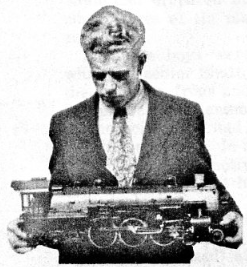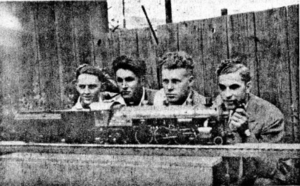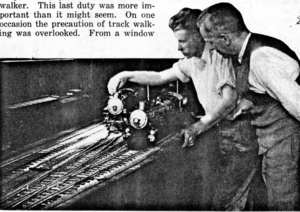IBLS Journal 1931
August
The following story appeared in the employee bulletin, "The Western Electric News", for August-1931.
Railroading at Home
The Shattocks of San Francisco Derive Dividends of Pleasure and Enjoyment from Building and Operating Their Own Railroad
A glow of red from the engine cab, and string of lighted windows, the long blasts of a whistle -- and a train whirs on through the night. What boy has not been thrilled by such a sight! Fascination for the trains that move ceaselessly on the great steel arteries of our country does not lessen as the boy grows into manhood. Its appeal seems ever new and to some it is so strong that they build railroads of their own.
Such a builder is Ronald J. Shattock of the San Francisco House, and his railroad is in his own back yard. The building of models is virtually a hereditary avocation for Ronald. His father began constructing miniature trains and boats as a boy and when he grew to manhood, his two sons, Ronald and Jim, fell heir to the mechanical toys that boys dream about. At an early age both boys began to assist their dad carry on his hobby of making models.
About seven or eight years ago dad and the boys decided to make a complete railroad system. At school Ronald and Jim had become proficient in wood working and it was agreed that the boys should make the car bodies while the father made the wheels and understructure. At first the boys had built many more bodies than there were completed wheels but at this stage of work they learned the value of good workmanship and after visits to local freight yards with a two foot rule, many details were added and some of the bodies were consigned to the scrap heap.
In doing this work Ronald developed the ability to draw accurately to scale which aided considerably. A sufficient amount of rolling stock had been built, five box cars, two flats, one tank car, one gondola and a caboose, and as they had two locomotives on hand, they decided to tackle the rails and roadbed next. it was a long time before they were ready to build a type 2422 passenger locomotive.
Adjacent to the Shattock home at the time the road was being built was a large fenced-in lot on the rear of which was an unoccupied barn about 40 by 16 feet. Using second-hand one inch by eight feet boards, a platform four feet wide and three feet high was constructed the length of the barn. many plans for the road were drawn up and many were discarded. The final one provided for a continuous main line which led into a terminal by the moving of switches, storage tracks, passing tracks, water tank and stand pipe, roundhouse and freight platform.
In carrying out their program, economy was the watchword. for the 2,000 ties needed, they bought a bundle of one-quarter inch thick redwood shakes for 75 cents. Four dollars' worth of No. 9 galvanized wire in short lengths was converted into rails. Then, like real Empire builders, the Shattocks began the construction of their road. The boys laid the ties while dad prepared the rail for laying by soldering small pieces of tim plate to the wire at intervals of six inches.
Soon the boys were doing this work themselves while the senior Shattock devoted his time to making the switches, frogs and guard rails. About this time it was decided to extend the track around the lot and at one point they had to construct a tunnel through the chicken house. In true railroad style, a work train consisting of locomotive, two flat cars, one gondola, and caboose was put into service.
With steam up, the train was kept as close to the "rail head" (the point to which construction progressed) as possible. In the gondola were the tools, such as hammers, pliers, etc., the flat car carried the rail and ties while a section push car containing the brads (rail spikes) was moved ahead on the roadbed. When supplies were depleted the train made a trip back for replenishments.
When traffic on the Shattock Railroad was inaugurated, almost every railroad operation could be carried out. When putting the road into operation, the usual procedure was to fire up the switch engine first and after a few turns up and down the track, the boys (dad is one of the boys in this business of miniature railroading) prepared to make up a freight train. By the time the switch engine had the cars lined up, the freight locomotive was coming out of the round house with steam blowing from her cylinder cocks.
Ronald was engineer of the freight engine and Jim of the switcher while dad was chief dispatcher, yardmaster and track walker. This last duty was more important than it might seem. On one occasion the precaution of track walking was overlooked. From a window in the barn, the boys watched the freighter with tender first "hit it up" as it rounded the outside extension and approached the tunnel.
Suddenly the roar of the wheels on the wooden roadbed stopped. Something had happened in the tunnel. A hurried investigation followed. Peering into the tunnel, the boys saw that the wheels of the locomotive were spinning around but the tender had been derailed and was held firmly by the sacking that lined part of the tunnel. when the tender had been released it was discovered that a hen had visited the tunnel and laid an egg between the rails. The egg derailed the tender but lost out in the final tussle.
When the boys were satisfied that the railroad was operating smoothly they decided to add switch levers and block signals to their system. The former caused little difficulty but the signals presented quite a problem. Besides scaling the fixtures one-half inch to the foot, the semaphore had to operate correctly in accordance with the position of the train on the track and it was desired to have such semaphore standards complete in itself so that it could be moved from one position to another by merely disconnecting a pair of wires. To accomplish this the mechanism to operate the signal arm had to be contained in the base of the pole which measured 3/4 by 1 by 2 inches.
Ronald who was adept at building radios was assigned this task and after experimenting with wire wound around nails and magnets removed from electric bells, he perfected a miniature signal system.
Many visitors have come to the Shattocks home to see the railroad in operation and one day a Southern Pacific official car made a stop-over in town. Word came to the Shattocks that three railroad officials would like to see their road in operation. The boys were delighted and when their visitors, one of the whom was T. F. Rowlands, then Southern Pacific western Division Superintendent, arrived all was in readiness with "steam up". The trains were put through various moves common to railroading and a tug of war between the two locomotives was staged as an added attraction.
Parts of the railroad have been exhibited many times and on one occasion it was used at a gathering of railroad union men to haul sandwiches and coffee from the kitchen to the dining tables.
At present time improvements and additions are being made to the rolling stock. And the cars have been equipped with springs and they ride like Pullmans. The wire track has been scrapped and is being replaced by the correct pattern 150 pound rail scaled one-half inch to the foot. Today the pride of the Shattock Railroad is a Pacific type 2422 passenger locomotive which is a miniature replica true to all details, to its powerful prototype.
To derive the greatest pleasure from this hobby, certain essentials should be watched. After deciding to use steam, procuring drawings, and determining the scale of the model and the gauge of the materials comes the question of operation.
If the model is to be run frequently, then the drawings must be modified. It is next to impossible to operate a model locomotive if all the valves and fittings are made to scale. First, their size would render them unsubstantial. Then it is difficult and unpleasant to grope around inside the cab for the throttle lever, for instance, with the chance of taking hold of a hot steam pipe.
The lubricators should be large enough to contain sufficient oil for the valves and cylinders and their size should make them convenient for filling. The fire control box, all hand operated valves and levers should be located so that they can be operated with comparative ease. Such deviations from scale can be carried out without being conspicuous and will in no way detract form the model's appearance.
It should also be remembered that parts may need repair or renewal. The smoke box front end should be completely removable thus permitting access to the seam pipe connections, the cylinders, the blower, superheater and the exhaust. The cab should be detachable and the boiler should be removable from the frame by the uscrewing of a few pipe unions and bolts. The pleasure to be derived from operating model locomotives depends largely upon the observance of these factors.



